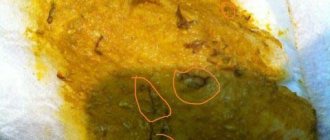The main causes of black stool in children
Changes in stool color are possible in children from birth, literally at the very first bowel movement and throughout childhood. But it is important to monitor the general condition when changing color. If the child is outwardly healthy, he has no abnormalities in his health, he is active and cheerful, does not complain about his tummy, there is no apathy or weakness, lethargy, you should immediately remember what foods or medications he took the day before. Often they are associated with a change in the color of the stool.
Important
A dangerous combination will be darkening or blackness in the stool against the background of a febrile syndrome, a sharp deterioration in the condition when the baby is pale and lethargic. This could be a serious health problem, in which case you need to call a doctor or an ambulance.
In any case, if something worries parents, it is worth seeing a doctor, even with an apparently healthy child, and undergoing at least a minimal examination.
Black feces in newborns
During the newborn period, while the mother and child are still in the maternity hospital, the baby may have black feces - meconium. This is not considered a pathology, but in fairness it is worth noting that the color of meconium is very variable, from olive green to brownish, almost black. Such stool was formed in the baby in utero from amniotic fluid with epithelial cells, which are always present in them, as well as from the desquamated epithelium of the baby’s intestine itself. The original feces must pass after birth, when the baby begins to actively adapt to extrauterine life. If meconium passes before birth, this is a dangerous sign of fetal hypoxia.
So, from the first or second day the baby empties his intestines and passes dark, almost black stools. It has the consistency of putty, is difficult to wash off the baby's skin and diapers, has no odor, and the volume of meconium reaches 1-2 teaspoons. The entire volume of stool may pass at once, or it may happen in small portions several times. The consistency of such original feces is homogeneous, without impurities and inclusions, fresh blood and mucus. As the intestines empty, bright yellow, thin stools begin to be released . If there is no bowel movement for two days or more, it is important to inform the maternity hospital doctor about this during the round.
Black feces in children of the first year of life
Before the introduction of complementary foods, children's stool is bright yellow with whitish splashes for infants, and yellow-brown in the form of a mush for artificial ones. Changes in the consistency and color of stool are typical of nutritional changes that occur as complementary foods are introduced. The first stool can almost completely repeat in color those dishes that are given to the child, since only a small part of the food is digested at first, the rest is passed out with the stool.
It is possible to stain the stool with products that have a dark, rich color - this is usually produced by ordinary beets. The puree from it that the child eats, due to partial digestion, produces almost black stool with some reddish-cherry stool. In addition, food iron that is not fully absorbed from foods other than breast milk or formula can also give such a reaction. At first, it is not completely absorbed in the intestines, it oxidizes and gives a color change. The stool is usually dark or almost black.
Among complementary feeding products, bananas or apples, cherries with cherries, blackberries with blueberries or black currants, animal liver, and grapes (dark) can cause blackness in the stool of a healthy child. Juices that contain iron or are dark in color can also cause stool color to change. This fact does not require changes in nutrition if the child feels quite well against the background of such stool.
Black stool when taking medication
If a new food is introduced to the child (complementary foods or mixtures with iron), the stool may also turn a deep dark color, even black. This is formed by iron salts that are not completely absorbed in the intestines. This does not require worry or discontinuation of the mixture; gradually the baby’s body will get used to digesting new food.
Multivitamins with iron, which are prescribed to a child for the treatment or prevention of certain pathologies, can often cause black stool staining. Iron preparations are black in color; their presence in the stool causes it to turn black. The most lasting and pronounced change in the color of stool is the iron supplements themselves, which are used in children to treat anemia. Whatever they are - drops, syrup or tablets, they significantly change the color of the stool - this is quite normal.
Also, coloring of the stool is typical for taking activated charcoal in the treatment of digestive disorders or eliminating poisoning . The drug is not absorbed in the intestines, but, on the contrary, absorbs all harmful toxins and poisons, leaving the intestines in the form in which it was taken. As the medications are stopped, the stool returns to its normal color.
Black stool when bleeding
One of the dangerous causes of darkening of stool is blood in the stool, which has coagulated and led to a change in color. It can occur as a result of nosebleeds in a child if he throws his head back and some of the blood enters the esophagus and stomach. Usually the stool turns black the next day, and it is important not to be alarmed by this phenomenon.
Blood may appear if there is an injury to the esophagus and bleeding from it, or if the structure of the esophageal veins changes due to some serious diseases that are rare in children.
In teenagers, black stool can be the result of a stomach or duodenal ulcer. Against this background, there is abdominal pain, weakness, poor appetite and pallor.
Black stools can be caused by diverticula and intestinal polyps, Crohn's disease or ulcerative colitis. Persistent constipation and anal fissures can lead to darkening of the stool, but fresh blood in the stool is usually typical.
Nutritional Features
A child's stool may turn black due to the consumption of certain foods. For example, prunes, blackberries, cherries, currants, beets, pomegranates, apples, kidneys, liver and many other foods that have a high iron content can stain feces. The stool may be completely black or have black spots if the food consumed is not completely digested. In addition, the dark color of the stool may persist for several days.
Sign of bleeding in children
Important
If a child eats regular food that does not have the property of coloring the stool, does not take vitamins with iron and preparations with it, and his stool is black, interspersed or throughout the cylinder, one can suspect bleeding from different parts of the digestive tube (melena - black feces from for blood).
Typically, such pathologies are characterized by a general deterioration of the condition and the appearance of certain symptoms. These include the baby's pallor, especially on the face, which has a waxy tint. There may also be abdominal pain, nausea and vomiting, sometimes with blood or “coffee grounds” (blood that has coagulated from stomach acid). Danger is the absence of stool for a long time and failure to pass gas, frequent constipation, fever with severe weakness, fainting with dizziness . It is important to describe such symptoms to emergency doctors and also say that the stool was black. Bleeding from the digestive tract can be the result of injury, damage from sharp edges of food (bones, foreign objects), as well as various diseases of both the digestive tract itself (ulcers, diverticula, erosions) and hematopoiesis, systemic pathologies that provoke bleeding.
Normal baby stool
A breastfed baby's stool is yellow or slightly green and has a soft texture. It can be quite liquid, with a consistency similar to porridge. There are many normal shades of baby stool. One of them is a greener tint, which means that mom ate something not entirely typical of her diet. When your baby has no other symptoms, there is no reason to worry.
As a rule, every parent knows what stool color is normal for their child. Therefore, when the stool becomes unusual, it is impossible not to notice.
Tactics of parents in the presence of black feces
If a child has blackened stools, it is important to initially assess his condition and analyze his diet, as well as any new medications that have appeared in his diet. It is important to carefully evaluate the baby’s condition, especially such manifestations as moodiness, lethargy or weakness, severe drowsiness outside of normal bedtime, and abdominal pain. If the child answers the usual questions normally, is well oriented in space and time, and does not complain about his health, you need to observe him for several hours. If there are repeated episodes of black stool that are not associated with diet and medications, you need to visit a pediatrician and have a stool test (coprogram). The doctor will definitely ask what foods the child ate two days before the visit; it is important to remember all of them in detail.
Important
If abdominal pain or vomiting, nausea occurs, children faint, they are very lethargic and pale, an ambulance must be called immediately and hospitalization in a surgical hospital.
It is important to inform emergency dispatchers of all alarming symptoms so that the ambulance arrives as soon as possible. It is important to note whether the child had any injuries or falls, whether he could have swallowed sharp objects or bones, or nut shells with sharp edges.
How is the examination carried out?
If certain digestive diseases or surgical pathologies are suspected, a number of examinations of the child are carried out. These include primarily a general blood test. It evaluates hematocrit (the ratio of plasma to blood cells) and hemoglobin with the level of red blood cells. With blood loss and internal bleeding, they are reduced, and the ESR rate increases. In a biochemical study, the levels of proteins and urea may be changed; blood is also needed for coagulation; its indicators may be changed in certain pathologies of the body that lead to bleeding. It may also be necessary to determine the volume of circulating blood, if technically possible in the clinic.
From instrumental studies, the child undergoes an abdominal x-ray, if necessary with contrast, as well as computed tomography. They can indirectly indicate the source of bleeding in the digestive tract.
EGD is also indicated - examination with a special system with a camera and illumination at the end of the tube, the condition of the mucous membranes of the esophagus, stomach and the initial part of the small intestine for ulcerative and erosive defects, bleeding and injuries. Diagnostic laparoscopy or sigmoidoscopy may also be prescribed.
Depending on the specific diagnosis, the treatment tactics for the child are already determined, right up to surgery.
Alena Paretskaya, pediatrician, medical columnist
28, total, today
( 37 votes, average: 4.73 out of 5)
Beer while breastfeeding: how long does it take for it to leave the body?
Methods of childbirth: water birth, vertical birth, home birth, etc.











